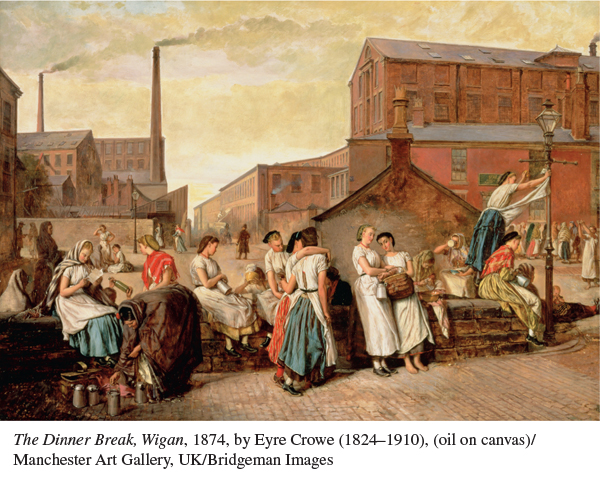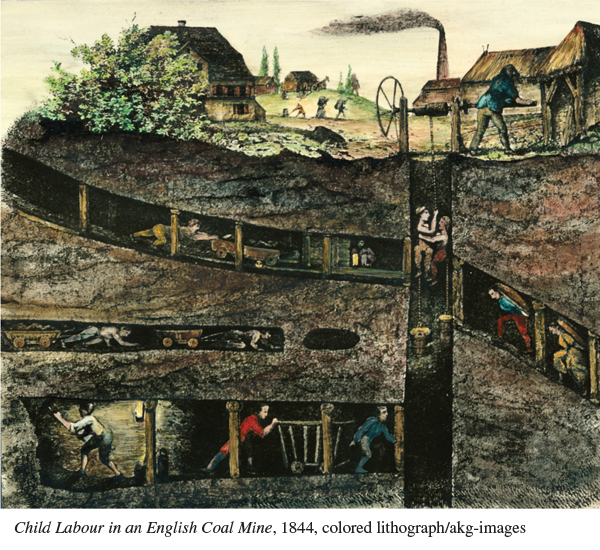A History of Western Society: Printed Page 666
A History of Western Society, Value Edition: Printed Page 640
A History of Western Society, Concise Edition: Printed Page 666
Chapter Chronology
The New Sexual Division of Labor
With the restriction of child labor and the collapse of the family work pattern in the 1830s came a new sexual division of labor. By 1850 the man was emerging as the family’s primary wage earner, while the married woman found only limited job opportunities. Generally denied good jobs at high wages in the growing urban economy, wives were expected to concentrate on their duties at home.
This new pattern of separate spheres had several aspects. First, all studies agree that married women from the working classes were much less likely to work full-time for wages outside the house after the first child arrived, although they often earned small amounts doing putting-out handicrafts at home and taking in boarders. Second, when married women did work for wages outside the house, they usually came from the poorest families, where the husbands were poorly paid, sick, unemployed, or missing. Third, these poor married or widowed women were joined by legions of young unmarried women, who worked full-time but only in certain jobs, of which textile factory work, laundering, and domestic service were particularly important. Fourth, all women were generally confined to low-paying, dead-end jobs. Evolving gradually, but largely in place by 1850, the new sexual division of labor constituted a major development in the history of women and of the family.
Several factors combined to create this new sexual division of labor. First, the new and unfamiliar discipline of the clock and the machine was especially hard on married women of the laboring classes. Relentless factory discipline conflicted with child care in a way that labor on the farm or in the cottage had not. A woman operating earsplitting spinning machinery could mind a child of seven or eight working beside her (until such work was outlawed), but she could no longer pace herself through pregnancy or breast-feed her baby on the job. Thus a working-class woman had strong incentives to stay home, if she could afford it. Caring for babies was a less important factor in areas of continental Europe, such as northern France and Scandinavia, where women relied on paid wet nurses instead of breast-feeding their babies (see Chapter 18).

Women Workers on Break This painting from mid-nineteenth-century northern England shows women textile workers as they relax and socialize on their lunch break. Most of the workers are young and probably unmarried.
(The Dinner Break, Wigan, 1874, by Eyre Crowe [1824–1910], [oil on canvas]/Manchester Art Gallery, UK/Bridgeman Images)
Page 668
Second, running a household in conditions of primitive urban poverty was an extremely demanding job in its own right. There were no supermarkets or public transportation. Shopping, washing clothes, and feeding the family constituted a never-ending challenge. Taking on a brutal job outside the house — a “second shift” — had limited appeal for the average married woman from the working class. Thus many women might well have accepted the emerging division of labor as the best available strategy for family survival in the industrializing society.7
Third, to a large degree the young, generally unmarried women who did work for wages outside the home were segregated from men and confined to certain “women’s jobs” because the new sexual division of labor replicated long-standing patterns of gender segregation and inequality. In the preindustrial economy, a small sector of the labor market had always been defined as “women’s work,” especially tasks involving needlework, spinning, food preparation, child care, and nursing. This traditional sexual division of labor took on new overtones, however, in response to the factory system. Previously, at least in theory, young people worked under a watchful parental eye. The growth of factories and mines brought unheard-of opportunities for girls and boys to mix on the job, free of familial supervision. Such opportunities led to more unplanned pregnancies and fueled the illegitimacy explosion that had begun in the late eighteenth century and that gathered force until at least 1850. Thus segregation of jobs by gender was partly an effort by older people to control the sexuality of working-class youths.
Investigations into the British coal industry before 1842 provide a graphic example of this concern. (See “Evaluating the Evidence 20.2: The Testimony of Young Mine Workers.”) The middle-class men leading the inquiry professed horror at the sight of girls and women working without shirts, which was a common practice because of the heat, and they quickly assumed the prevalence of licentious sex with the male miners, who also wore very little clothing. In fact, many girls and married women worked for related males in a family unit that provided considerable protection and restraint. Yet many witnesses from the working class also believed that the mines were inappropriate and dangerous places for women and girls. Some miners stressed particularly the danger of sexual aggression for girls working past puberty. As one explained, “I consider it a scandal for girls to work in the pits. Till they are 12 or 14 they may work very well but after that it’s an abomination. . . . The work of the pit does not hurt them, it is the effect on their morals that I complain of.”8 The Mines Act of 1842 prohibited underground work for all women and girls as well as for boys under ten.

Child Labor in Coal Mines Public sentiment against child labor in coal mines was provoked by the publication of dramatic images of the harsh working conditions children endured. The Mines Act of 1842 prohibited the employment underground of women and girls, and boys under the age of ten.
(Child Labour in an English Coal Mine, 1844, colored lithograph/akg-images)
Page 669
Some women who had to support themselves protested against being excluded from coal mining, which paid higher wages than most other jobs open to working-class women. But provided they were part of families that could manage economically, the girls and the women who had worked underground were generally pleased with the law. In explaining her satisfaction in 1844, one mother of four provided real insight into why many married working women accepted the emerging sexual division of labor:
While working in the pit I was worth to my [miner] husband seven shillings a week, out of which we had to pay 2½ shillings to a woman for looking after the younger children. I used to take them to her house at 4 o’clock in the morning, out of their own beds, to put them into hers. Then there was one shilling a week for washing; besides, there was mending to pay for, and other things. The house was not guided. The other children broke things; they did not go to school when they were sent; they would be playing about, and get ill-used by other children, and their clothes torn. Then when I came home in the evening, everything was to do after the day’s labor, and I was so tired I had no heart for it; no fire lit, nothing cooked, no water fetched, the house dirty, and nothing comfortable for my husband. It is all far better now, and I wouldn’t go down again.9
A final factor encouraging working-class women to withdraw from paid labor was the domestic ideals emanating from middle-class women, who had largely embraced the “separate spheres” ideology. Middle-class reformers published tracts and formed societies to urge poor women to devote more care and attention to their homes and families.

